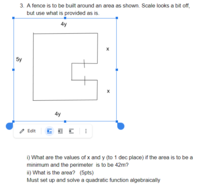wrterynern
New member
- Joined
- May 10, 2020
- Messages
- 7
I've been trying to do this for a while and I cant even figure out how to make an equation for it. I think some info is missing as from my understanding its impossible to create an equation if the 2 lines that are the same (the lines with the lines on them) are not possible to relate to anything. My tutor and and online tutor I found both couldn't figure it out. I emailed my teacher asking if anything was missing he said no. This is for pre cal 11 and in the quadratics unit.
Any help would be great
Thanks

Any help would be great
Thanks

